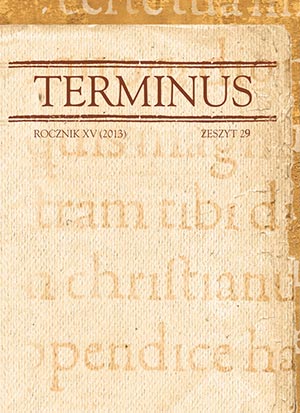Panegiryk Do Jakuba z Sienna a początki poezji humanistycznej w Krakowie w XV wieku
The panegyric To Jacob of Sienno and the beginnings of the humanistic poetry in Krakow in the 15th century
Author(s): Jakub Niedźwiedź Subject(s): Literary Texts
Published by: Wydawnictwo Uniwersytetu Jagiellońskiego
Keywords: neo-Latin poetry in Poland; panegyrics; early Humanism in Poland; Polish-Italian relationships in the 15th century; the University of Cracow; Jakub z Sienna (Jacob of Sienno); Zbigniew Oleśnicki; Leonardo Mansueti
Summary/Abstract: The paper has two aims: one is to publish a critical edition of an early humanistic poem, the other is to explain the circumstances in which it was written. The study engages the traditional methods of textual criticism. The author analyses several sources, among them the manuscript 802 preserved in the Kórnik Library which contains the poem. In the first part of the paper Jacob’s biography is reminded. Jacob of Sienno (Jakub z Sienna, 1413–1480) was a diplomat, a politician, the bishop of Kujawy and next the archbishop of Gniezno. He was born in an nobleman family, studied in Rome and in the mid 1430’s pursued his ecclesiastical and political career. He turned back to Italy many times, both as a royal diplomat and a political refugee during his conflict with king Casimir IV Jagiellon. The author stresses the fact that in his Italian journeys he must have come in contact with the early Humanistic culture, which is proved for instance by his collection of Renaissance decorated books acquired in Italy. In the second part the author reveals the circumstances in which the poem was written. The deliberations here touch upon the problem of authorship. Although some researchers made aconjecture that the author would have been Leonardo Mansueti (1414–1480), the Master General of the Dominican Order and Jacob’s friend, a hypothesis that an anonymous Cracow scholar would have been the grateful poet is more convincing. The author reminds a long-standing relationship between Jacob and the University of Cracow. As a patron of the university the bishop made it a gift of his library. The third part contains analysis of the text. The poet drew a picture of a bishop-good shepherd and a wise statesman devoted to the country. To construct such a figure, typical for Renaissance literature in the next century, he employed the classical rhetoric, astrology and especially the Stoic philosophy. The analysis leads to the conclusion that To Jacob of Sienno can be one of the first Humanistic panegyrics in Poland. It can be considered a result of Jacob’s patronage on literature and fine arts. At the end the author asserts that the bishop courts in Poland in the 15th century were important centres of Humanistic culture, among them Jacob’s court. Future research on this topic can shed new light on the beginnings of the Renaissance in Poland. Additionally, the paper provides critical edition of the Latin text and its Polish translation with commentaries
Journal: TERMINUS
- Issue Year: 15/2013
- Issue No: 4 (29)
- Page Range: 485-512
- Page Count: 29
- Language: Polish

